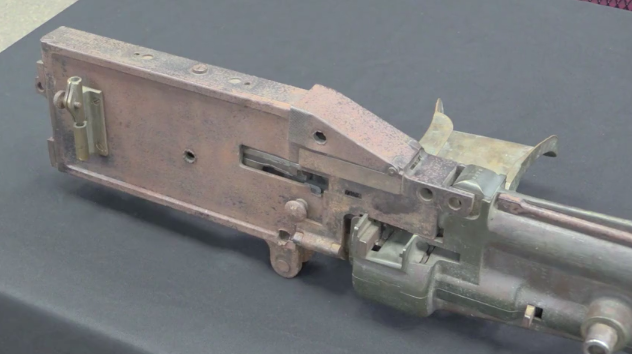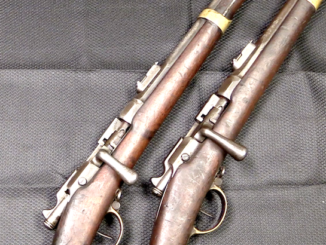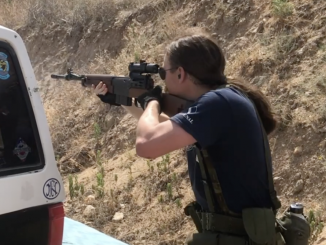Today we have a short look at two of the predecessors of the French MAC 1950 service pistol. The first is the Type SE MAS 1948, which retains many of the characteristics of the previous MAS 1935 pistols. After that is a preproduction MAC 1950 (serial number F 20), which has the same style of safety catch as the pre-M1 MAS 1935, as well as early wooden grips. Then, of course, is the standard pattern of the normal MAC 1950.
Many thanks to the IRCGN (Institut de Recherche Criminelle de la Gendarmerie Nationale) for allowing me access to film this progression for you!




Interesting it never got much traction in the US. Granted, it’s a French gov’t design, but practically it’s the contemporary of the Browning Hi-Power.
I doubt any American used to the 1911 would have any truck with such a hinky safety catch. How can you trust a catch which actually protrudes from the rear of the frame?
I also see the lunatic with the nail polish has been daubing the rare examples yet again. What can have possessed them?
Probably because they, like a number of other institutions, discovered that they had -for example- a number of Polish wz 35 pistols with the same serial number in their inventory.
Because institutions are not only staffed with gun-buffs, some had taken the prominent patent number for the serial number.
To avaoid this on the next stock taking, the serial number is clearly marked for the paper pushers.
Exactly. Don’t bother to employ people who know what they are doing, just daub the exhibits with paint.
I think you missed that this set of pistols does not belong to a museum; instead, they belong to the reference collection of IRCGN (Institut de Recherche Criminelle de la Gendarmerie Nationale).
Couple of things implied by that: One, this is a working collection, managed more than likely by the armorers of that institution. Who are unlikely to be trained conservationists, or even all that worried about preservation of the artifacts they’re responsible for…
Two, the purpose of this collection is not historical conservation; it is, as best I can tell, to be used in training criminalists and police officers. As such, these collections are not going to be managed as they would be by an actual museum.
I know exactly why they did what they did with those colored outlines: To speed up the process of inventory. Every day you open an arms room, you have to do at least a sight inventory of that arms room. Once a month, or so, a disinterested third party has to come in and do a by-serial number inventory to verify that the armorer hasn’t sold the damn things off on the black market, and that inventory has to be done as quickly as possible without the armorer’s involvement. Why? Because third-party verification…
On a collection of standard issue firearms, you find one serial number, you know where the rest are going to be. You’re dealing with an eclectic collection of different firearms, like the ones an SF team might have stashed away for training…? Lord love a duck, but you’d better have some shortcuts figured out, because it’s going to take fer-f*cking-ever to do if every inventory turns into a re-invention of the wheel.
One of the SF battalions with which I’m familiar had a three-ring binder full of pictures of the weapons and where the serial numbers were to be found on them. The inventorying officer would have to have that binder, the serial number list, and be going through the collection of weird crap that they’d accumulated for at least a couple of hours, every single month.
The administrivia required for all that crap was why a lot of those collections got turned in for destruction; too much time going into keeping track of everything. Like as not, if those serial numbers weren’t highlighted, someone on the admin side of things would have long since said “This is too much trouble; melt these down…”
Again, the weapons Ian has shown us in these glimpses into the Gendarmerie’s holdings are not being cared for by museum curators, but by working cops and armorers. Make it too much of a pain to do the admin requirements, and… Yeah. The collections will go away. And, not to a museum, either… At least one SF collection I’m familiar with went to the crusher at Rock Island, and there were some really unique items in that one. Like bring-backs from Vietnam with actual capture-card provenance that would blow your mind with historical connections to people you only get to read about in books, these days.
Kirk:
A fair point, and I appreciate that it might just be me who objects to rare old guns being daubed with nail polish. However, these are historic arms. I doubt that the French Gendarmerie are going to come across many prototype pistols or machine guns from the 1940s in their ordinary operations, and so I am going to stand by my objection. But I appreciate your point. The French did invent the word “bureaucracy” after all.
The “nail polish” paint is not going to hurt the steel and is easy to clean off with solvent. Looks ugly, but is no problem.
We had painted the last four numbers on the buttstocks of our G3 rifles in the Bundeswehr forbeasier inventory control. They came from a continueous block of serial numbers luckily. That made things easy to count.
The administrivia of managing the weapons for issue and storage is always overlooked by the designers and the planners. Not to mention, the collectors…
Case in point: M1/M14 were easily inventoried because the serial number was right there on the tang of the receiver. You didn’t even have to take the rifles out of the rack; just look at them still there. Made inventories a snap…
Came the M16? LOL… Dumbasses put the serial number on the side of the lower, so every time you inventoried the serial number, there ya go… Open the rack, pull it out, compare the number, and… Yeah. You needed three hands or a second body, one to get the weapon out and one to hold the clipboard. Which always led to confusion, because the poor bastard Second Lieutenant would always get given the lowest common denominator troop in his platoon as a “helper”. Because, platoon sergeant ain’t wasting someone who was actually, y’know… Like useful, on that detail…
Old timers told me stories about monthly inventories only taking about an hour, or so, back in the halcyon days of yore, when men were men and they had Real Rifles that fired Real Manly Cartridges…
Having spent a fair number of hours in my career managing Arms Room and weapons-related affairs, it’s my opinion that they don’t put enough emphasis or attention on these things. The “painted ladies” are a perfect example of work-arounds you have to subject yourself to.
When I was first an armorer, I had three weapons whose serial numbers were always problematic; due to wear and/or bad stamping, they were hard to read, and the question of just what those damn numbers were was always argued over. It wasn’t until late in my tenure that I found out that the guys up at Third Shop could re-stamp a receiver to clarify that sort of thing…
You would think that all of this sort of thing would be a part of the procurement process, but… Nope. Not a bit of it.
Sommerbiwak:
I hope you are right about the nail polish treatment. I would not care to use it on a nicely blued gun, I doubt it would improve the finish.
Great video! Thank you sir!